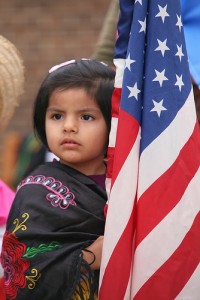Latino Childhood Poverty Sets Record
 The headline across the top of a Pew Hispanic Center press release is ominous: The Toll of the Great Recession.
The headline across the top of a Pew Hispanic Center press release is ominous: The Toll of the Great Recession.
The body of the story doesn’t get any better.
More Latino children are living in poverty—6.1 million in 2010—than children of any other racial or ethnic group. This marks the first time in U.S. history that the single largest group of poor children is not white. In 2010, 37.3% of poor children were Latino, 30.5% were white and 26.6% were black.
Consider this the shadow side of all the good news and potential we’ve been talking about lately: the increase in U.S. Latino population, the relative youth of the Latino community, the potential for the national workforce, politics and education. Latino kids have begun to tip the scales in the number of children in elementary school classrooms, and now we get to look behind the curtain.
In 1976 1.4 million Latino children lived in poverty, in 2010 that number increased to 6.1 million. But a more stark statistic is that since 2007, a mere three years, that number climbed from 4.5 million to 6.1 million. That incredible jump that put Latino kids at the top of the poverty heap (or bottom, depending on your perspective) occurred during the Great Recession.
And it hasn’t ended. While experts fret over the “jobless recovery” and top tier earners have put the bad times behind them, unemployment for Latinos remains high: the recession is no where near being over.
At its beginning, the unemployment rate among Latino workers increased rapidly, especially among immigrant workers. Today, the unemployment rate among Latinos, at 11.1%, is higher than the national unemployment rate of 9.1%. Household wealth among Latinos declined more sharply than either black or white households between 2005 and 2009. And according to the U.S. Department of Agriculture, food insecurity among Latino households increased sharply at the start of the Great Recession. In 2008, nearly a third (32.1%) of Latino households with children faced food insecurity, up from 23.8% in 2007.
This is a very different reality than the one that the politicians are harping about. But it couldn’t be any more relevant. Because if nations are judged by the manner in which they treat the least among them, we’re not doing well at all. We can easily say that the increase in poor Latino kids was due to same economic downturn that affected all Americans, and we’d be right. The problem, I think, is that while the economy was spiraling downward no one was paying attention to these kids, so why should they pay attention to them now?
No one noticed how dramatically these children were being pushed into unhealthy, undernourished conditions. There are no PAC’s to raise funding for their cause, no message machines to spin their side after a debate, no national movements that put them front and center of the discussions. And yet, this is the future workforce that we talk about; these are the children we’re relying on to become educated and lead us in the years to come; these are the kids we’ll all be depending on.
The difference? Today, those 6.1 million niños can’t vote.
[Photo by cliff1066™]

